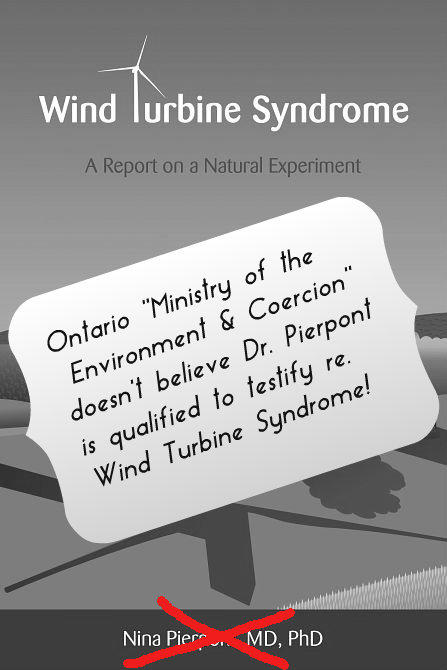
—Calvin Luther Martin, PhD
This is priceless!
On a different note, could you please advise of how you will ask the [Environmental Review] Tribunal to qualify Dr. Pierpont?
You have watched some hearings before, so you will likely know that a party tendering an expert witness will ask for a proposed witness to be qualified as having expertise in a particular area.
The Chair has asked for qualifications to be dealt with in advance of the beginning of the hearing so we ask that you provide the area of expertise that you intend to have Ms. Pierpont qualified in.
Katie Clements
Counsel
Ministry of the Attorney General
Legal Services Branch | Ministry of the Environment
135 St. Clair Ave. West, 12th floor
Toronto, ON M4V 1P5
Phone: 416-327-1425
Fax: 416-314-6579
Katie.clements1@ontario.ca
Priceless! This, alone, is worth the price of admission—to this freak show! I’m 65; I thought I had heard everything!
Ladies and gentlemen, you just read an excerpt from an email sent to Esther Wrightman from Attorney Katie Clements, wondering how on earth Dr. Nina Pierpont might demonstrate her qualifications to give expert testimony before the Ontario Ministry of the Environment on — Wind Turbine Syndrome.
Only in Ontario! (In Ontario, believe it or not people actually elect people who hire people like Mighty Katie!)
Note to Dr. Laurie: Notice how Nina Pierpont’s credentials are being smeared from “Dr. Pierpont” to . . . “Mizzz Pierpont.” Sound familiar? Do these jackasses all use the same How-To manual?
Welcome to the Ontario Environmental Review Tribunal Circus!

We need to know why these people are experiencing health problems. Over three years ago, I and other Massachusetts citizens requested that the Massachusetts Department of Public Health conduct a comprehensive study of the public health and safety impacts of the land-based wind turbines.
More than a year later, a panel was appointed by the Massachusetts Department of Environmental Protection. Following the department’s release of what it characterized at the time as preliminary findings were more than 500 comments with more than 4,600 pages. Most comments were highly critical of the limited literature review, the panel and the process. All meetings were held in secret with no public participation. No meeting minutes or accounts of any of the proceedings have been released.
—Lilli-Ann Green*, Cape Cod Times (9/26/13)
Many families and communities throughout Cape Cod and our commonwealth are being severely affected by land-based wind turbines. Individuals have developed health problems. Real estate prices have dropped. Otherwise peaceful towns are in an uproar over existing and proposed turbines.
There are concerns on both sides. Some people say that those living near wind turbines have become ill or can’t sell their homes, and that solar energy is more fiscally responsible and better for the environment.
Others say wind energy will save communities money and provides an appropriate source of renewable energy.
However, the fact is there are 21 confirmed locations in Massachusetts where people living close to wind turbines are reporting health problems they did not have before construction of nearby wind turbines.
The symptoms they report include sleep disturbance and deprivation, headaches, ringing in the ears, tachycardia (fast heart rate), dizziness, vertigo, nausea, visual blurring, panic and loss of concentration.
We need to know why these people are experiencing health problems. Over three years ago, I and other Massachusetts citizens requested that the Massachusetts Department of Public Health conduct a comprehensive study of the public health and safety impacts of the land-based wind turbines.
More than a year later, a panel was appointed by the Massachusetts Department of Environmental Protection. Following the department’s release of what it characterized at the time as preliminary findings were more than 500 comments with more than 4,600 pages. Most comments were highly critical of the limited literature review, the panel and the process. All meetings were held in secret with no public participation. No meeting minutes or accounts of any of the proceedings have been released.
State Rep. Sarah Peake has introduced a bill (H. 2048) that calls for the commonwealth to convene a health commission to study the health impacts from land-based wind turbines. This legislation is about conducting honest scientific and medical research, developing educational materials and developing training for health care professionals. Massachusetts citizens deserve no less.
H. 2048 is modeled after the highly successful Lyme Disease Commission bill, for good reason. In the early days of Lyme disease, just like the situation today with wind turbines, people who became sick and health care professionals did not have enough information to understand the problem. Many medical professionals told those who complained of health problems that the symptoms were psychosomatic. This assessment proved wrong.
It is time to quiet the rhetoric and make decisions regarding wind turbines by finding the real facts about the health impacts of the turbines.
.
* Lilli-Ann Green of Wellfleet is CEO of a health care consulting and quality improvement company and a board member of Wind Wise~Massachusetts, a statewide organization, and Windwise ~Cape Cod, a regional organization, both being alliances of grass-roots environmental groups and individuals.
Editor’s note: The following is a report on a demonstration recently held in Columbus, Ohio, against the American Wind Energy Association, which was holding a so-called Midwest Summit.
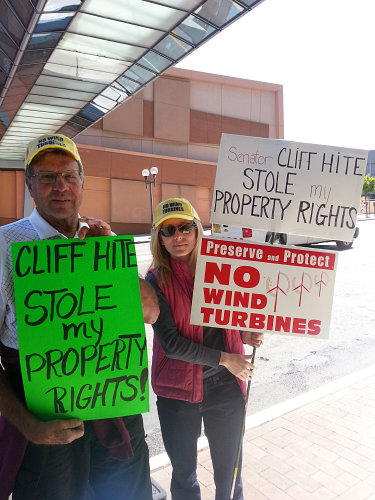

Friends,
A great day in Columbus, Ohio, with about thirty protesting citizens marching in front of the Hilton Hotel where the American Wind Energy Association was holding its Midwest Summit.
It was an IMPORTANT effort coordinated by the Interstate Concerned Citizens and Kevon Martis. We were joined by wind warriors from Indiana, Michigan and Pennsylvania! Thank you!
Woody Allen said once that “Eighty per cent of success is just showing up.” Amen. Please read the breaking coverage from the legislature’s news service. Woody was right.
Diane and Julie.
On the eve of a key senator’s unveiling of his plan to overhaul Ohio’s clean energy law, the wind industry warned that the proposed changes cloud a sunny forecast for renewable energy development in the state.
The American Wind Energy Association’s news conference on Tuesday kicked off what will likely be a pitched battle over Republican efforts to scale back the state’s renewable energy and energy efficiency requirements on electric utilities (SB221, 127th General Assembly).
Wind energy opponents also rallied against “industrial wind cronyism and taxpayer fleecing” in Columbus Tuesday afternoon, and the Ohio Advanced Energy Economy Institute scheduled a news conference Wednesday morning to tout a report on the benefits of the clean energy law.
Wednesday afternoon the Senate Public Utilities Committee is set to accept a substitute version of placeholder legislation (SB 58) that Chairman Sen. Bill Seitz (R-Cincinnati) introduced earlier this year.
Among other things, the substitute version would eliminate the requirement for half of the 12.5% of Ohio’s electricity supply to come from renewable energy facilities located in the state, Sen. Seitz said last month. The sponsor said a federal court ruling found in-state energy preferences elsewhere were an unconstitutional violation of the Commerce Clause. (See Gongwer Ohio Report, August 21, 2013)
Eric Thumma, director of institutional relations for Iberdrola Renewables, said the in-state renewable energy requirement was a “prime driver” for the company to construct the 304-megawatt Blue Creek Wind Farm in Van Wert and Paulding counties.
“The great thing about the Ohio requirement is you’re getting energy from Ohio, you’re getting investment in Ohio,” he said.
“The policies that the Ohio General Assembly put in place are working. We’re meeting the benchmarks,” he said, urging lawmakers not to alter the renewable energy portfolio standards (RPS).
Susan Innis, senior manager of public affairs for Vestas, said Ohio’s RPS, combined with a robust supply chain and proximity to wind farms, makes the state fertile ground for wind turbine manufacturers.
New technology that enables turbines to generate electricity with winds as slow as six miles per hour have also made wind power more viable in the state, she said.
Dayna Baird, contract lobbyist for AWEA, said changes to the RPS could jeopardize development of the seven proposed wind farm projects that have already been certified by the Ohio Power Siting Board and are ready to move forward.
Wind developers are waiting for electric utilities to issue the next request for proposals to secure a long-term contract before breaking ground on the projects, she said. “When the next RFP does come out, there’s going to be a lot of serious competition.”
Meanwhile, another group protested what it called “the lies and manipulation” of the wind industry and its legislative allies during a rally scheduled later in the day.
Kevon Martis, of Interstate Concerned Citizens, said elected officials allowed the industry to encroach on private property and endanger the wellbeing of rural residents.
“The emperor has no clothes and it is time the media and state legislatures admit it,” he said in a news release.
The wind industry is dependent on “massive public subsidy at both the federal and local level as well as on unconstitutional state mandates,” the group said, and warned that other countries are working to undo policies that encourage wind development.
“The U.S. and Ohio should learn from the failures abroad, and stop wasting taxpayer dollars on an endeavor destined to raise electricity rates, make the U.S. a less attractive place to manufacture and ultimately costing jobs,” Interstate Concerned Citizens said.
In other developments, the Ohio Advanced Energy Economy Institute said it would unveil an Ohio State University study that shows Ohioans will pay $3.65 billion more on their electricity bills over the next 12 years if Sen. Seitz’s proposal is enacted.
Ohioans saved 1.4% on their electricity bills since energy efficiency and renewable energy standards were enacted in 2008, according to the study. The law also stimulated investment in the energy sector that expanded gross domestic product by $160 million in 2012, and created more than 3,200 Ohio jobs in the period from 2008 to 2012.
Sen. Seitz has said his bill would also make it easier for electric utilities to comply with the state’s energy efficiency standards and limit the amount they could spend on the mandate.
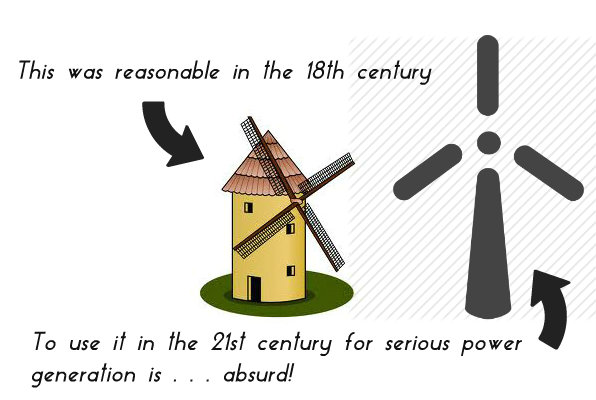
—Ben Acheson, “Huffington Post—UK” (9/23/13)*
Another week, another plethora of news reports attacking wind farms. The latest headlines include; November date for Trump’s wind farm challenge”, “Approval for wind turbines sparks protest at ‘ring of steel'” and “Wind turbines may be killing bats by ‘exploding’ their lungs”, to name but a few. Yet will the stories about Donald Trump, exploding bats and Scotland’s version of the Iron Curtain help to stem the spread of mammoth turbines across our land and seas?
Probably not.
Still, it was only two years ago that anyone who publicly opposed wind turbines was considered a social pariah and practically ostracised from society as if they were modern-day lepers. Things have changed. Not a day goes by without a new story slamming wind energy or highlighting the increasing wind farm opposition across the UK. Just as it was once popular to support wind energy, it has almost…almost…become fashionable to oppose wind turbines.
The problem is that many of the news reports are nothing more than filler. If they are printed on a Tuesday, they are forgotten about by Wednesday; such is the nature of the fast-paced, up-to-the minute, 24-hour news cycle that is available to us. Despite the constant barrage of anti-wind press, the spread of massive industrial wind turbines continues unabated.
In the last year alone we have seen news reports outlining how wind farms have surrounded some of Britain’s most untouched landscape and blighted some of our most bucolic and treasured towns and villages. We have heard horror stories about planning departments ignoring guidelines and forcing homeowners to live next to monstrous whirling steel turbines. We have been warned that property values have plummeted due to the inappropriate placement of wind farms and we have seen hundreds of anti-wind protest groups spring up across the nation, incensed at the lack of democracy in the planning system.
We have read how turbines impact human health and after years of mockery from pro-wind groups, we now have the first peer-reviewed, science-based report confirming that turbines do have harmful impacts on humans.
We have watched videos of turbines exploding in high winds and crashing to the ground in storms. We have witnessed precious habitats and ecosystems torn apart to make way for turbines and we have seen stories about birds being chopped to bits. We have heard how offshore wind farms will destroy precious undersea carbon stores, affect aquatic animals and close important fishing grounds.
We have been told that the tourist industry will be damaged and the golf industry will take a hit. We read explanations of how sailing routes will be impacted and even how Britain’s strategic nuclear deterrent could be hampered. The Ministry of Defence has objected to many wind farms which will affect radar systems and we have even seen how turbines could prevent the detection of secret nuclear weapons tests.
Mountaineers, ramblers, cyclists, equestrians, aviation enthusiasts and bird-watchers have protested. Celebrities have come out to support anti-wind campaigns. Members of every political party, except the Greens, have spoken out against turbines. Over 100 MPs petitioned David Cameron to stop the madness. Members of the European Parliament have repeatedly urged the European Commission to get involved. The Scottish Government has received 10,000 objections from people who oppose wind farms – and that was just for large developments (>50MW).
We have read that schoolchildren are being utilised as pro-wind propaganda tools and we have even seen how the United Nations has ruled that the UK is in breach of international law regarding public participation and the right to receive information in regard to wind farm developments. In the last few weeks, we have heard how IPCC climate change projections, which formed the basis for renewable energy targets, have been called into question by leading scientists.
We have watched as turbines have had to be shut down in high winds and how consumers foot the bill when they are. We have seen their minimal contribution the UK energy supply, even when they are needed most. We have been affected when energy bills have skyrocketed thanks in part to a misguided focus on wind energy. Unfortunately we have also heard how millions of households have been forced into crippling fuel poverty, now having to choose between food and fuel.
We have read about noise abatement orders and residents’ legal challenges. We have seen some communities torn apart by wind farm proposals and others handed bribes in return for their silence. We have read how landowners pocket exorbitant amounts of cash in return for housing turbines and we have seen developers reap vast profits from the UK’s subsidy regime. We have heard how peat bogs have been ripped up and forests torn down to make way for wind farms. We are now being told that wind energy has not made even the slightest difference to carbon emissions.
We have even seen those who peddle ridiculous pro-wind arguments about green jobs debunked and refuted. There is enough credible evidence and enough of an opposition to end a policy of support for industrial wind energy. Yet still we see wind farms popping up all around the country.
Isn’t it about time that we looked at all the evidence cumulatively? Isn’t it about time that we just chalked it up as a loss and tried something else?
.
*Ben Acheson is the Energy and Environment Policy Adviser and Parliamentary Assistant to Struan Stevenson MEP at the European Parliament in Brussels.

Let’s hope the Town of Falmouth comes to its senses and stops the abuse [of Wind Turbine Syndrome victims]”
—William Hallstein, MD
Psychiatrist (Falmouth, MA)
.
Jed Goldstone, Chairman
Falmouth Board of Health
September 13, 2013
Subject: Falmouth wind turbines and sleep deprivation
.
Dear Mr. Goldstone:
In way of introduction, I have been a Falmouth resident since 1970. I am a psychiatrist, my career working its way through its 44th year. Consultation/liaison psychiatry has been my primary setting. In this role one treats patients with combined physical and psychiatric illnesses in the general medical center population, be it medical, surgical or emergency units, in addition to the most severely psychiatrically ill patients admitted to locked psychiatric units and correctional institutions.
I am thoroughly acquainted with the turbine issues and neighbors who are affected. I have made it my business to spend significant amounts of time experiencing the turbine effects. I know exactly what they are describing and have experienced it (emphasis added).
Turning now to the topic of sleep interruption and deprivation. Sleep disturbance is not a trivial matter. Children with inadequate sleep perform poorly academically, emotionally and physically. Errors in judgement and accident rates increase with inadequate sleep and fatigue for everyone: athletes, truck drivers, ship operators , aircraft pilots and physicians. No one is exempt.
In the world of medicine, illnesses of all varieties are destabilized by fatigue secondary to inadequate sleep. Diabetic blood sugars become labile, cardiac rhythms become irregular, migraines erupt and increase in intensity, tissue healing is retarded, and so forth, across the entire field of physical medicine. Psychiatric problems intensify and people decompensate. Mood disorders become more extreme and psychotic disorders more severe.
People with no previously identified psychiatric illness are destabilized by sleep deprivation. Sleep deprivation experiments have repeatedly been terminated because test subjects become psychotic; they begin to hallucinate auditory and visual phenomena. They develop paranoid delusions. This all happens in the “normal” brain. Sleep deprivation has been used as an effective means of torture and a technique for extracting confessions.
I could work my way through the presentation of 43 years of sleep deprivation observations, but that is more than the scope of this letter. I am writing because I have witnessed Town of Falmouth officials and members of other boards trivialize symptom reports from people living close to the wind turbines. I have witnessed attempts to discredit people who are being hurt by the turbines.
Sleep deprivation breaks down individual defenses and mimics a broad range of physical and mental illnesses. Let’s hope the Town of Falmouth comes to its senses and stops the abuse.
Sincerely,
![]()
William Hallstein, MD
Falmouth, MA
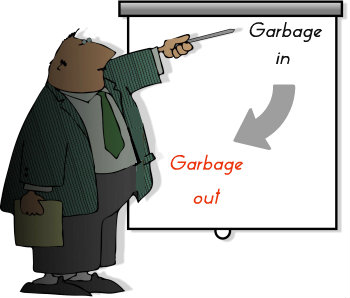
Editor’s note: The Lawrence Berkeley National Laboratory (LBNL) has released a new version of its property value analysis, assessing whether wind turbines degrade property value. Like their previous study, the authors conclude there is no appreciable loss in value. Click here to read the report.
It’s horseshit—just like the earlier attempt by Ben Hoen at al. to paper over huge property devaluation. Mike McCann, a Chicago-based property appraiser with sterling credentials, explains why it’s, well, horseshit. What the LBNL data really demonstrate is the following (in McCann’s words);
1,198 sales within 1 mile of turbines demonstrate a 28% lower value, and the data provides a compelling basis to determine there is a causal relationship between distance and impact.”
.
—Michael S. McCann
McCann Appraisal, LLC
Chicago, IL
.
The new LBNL value report has been placed with many media outlets, as part of the follow up public relations campaign to dismiss value impacts as a mere “concern”, while doing little to address the very real problem. I have received many requests for comment on the latest LBNL effort. A thoughtful review of the claims stated therein is warranted, and my preliminary remarks follow.
First, the August 2013 LBNL report conclusions should not be relied on for any purpose other than showing that statistics can be used to support any biased position they choose, but it is far from being an empirical value study. There was certainly enough data to perform a study that incorporated the accepted methodology of paired sales and/or resale analysis, with careful analysis of marketing times and other value influencing factors. But LBNL once again ignored the primary data source for residential values; the Multiple Listing Service (MLS) active in any given study area. (Marketing times do not show in Assessor data)
Once you bother to read through all the scientific sounding discussion and internally supported citations (Hoen citing Hoen, for example), I recommend that you refer to the last sentence of paragraph 2 on report page # 5, wherein the authors disclose an apparent bias as follows: “Therefore for the purposes of this research we will assume 3-4% is a maximum possible effect.”
Review of Table 7 arrays the data and reveals impact on a factual basis. The empirical evidence is presented on Table 7before the sale price data was “crunched” to obtain the stated results. On a side note, the focus is on claims of statistical significance; not upon value impact.
Regardless of terminology or focus, the fact is that the raw data shows a post construction negative impact of 28% for homes < 1 mile from turbines vs. homes in the 3-10 mile range, as follows:

Second, the methodology utilized in the LBNL analysis is not an accepted, proven regression model. It pools data from 67 different projects in 27 counties in 9 states, and simply cannot be deemed reliable because of the wide value variations that exist between these local markets. To the contrary, it insures that the variables have such wide variation that any impact measured after running the data through their hedonic “model” will not be able to identify any impact at the level needed to establish statistical significance (see Al Wilson, Rubber Rulers)
In contrast, however, the raw data is substantively significant, as it shows the real market reaction, without any assumptions, alteration or adjustment of the numbers, and no built in bias (i.e., 3% to 4% max impact). (Click here.)
Further, given that the Table 7 data includes 1,198 sales located within 1 mile of turbines, and also that it covers 67 different projects, it seems quite clear that there is a high level of casual significance to establish there is a direct relationship between distance and value impact, and these market reactions are commonly repeated throughout the USA.
The attached Rubber Rulers paper by Al Wilson addresses the numerous problems with the 2009 LBNL analysis, and it appears that the majority if not all of these problems are replicated in the 2013 LBNL report. (Note: see Wilson bio. This professional appraiser literally wrote the book on environmental impact on property values and other value impairment research, statistical standards studies, etc.)
What non-appraisers (i.e. LBNL authors) refer to as “anecdotal” evidence, in their attempts to dismiss actual examples of value loss, is what appraisers refer to as Comparable Sales and other market evidence. From an appraisal perspective, the 1,198 sales within 1 mile that find a 28% loss of value is meaningful, but actual local examples are potentially a higher level of proof.
Realtors such as Annie Cool (Falmouth, MA) are in the trenches on this issue, and consistently find that buyers will not pay prices that are at “no turbine proximity” value rates, and that most buyers simply will not even make an offer on homes near turbines. Homes that sit on the market for extensive periods of time have downward pressure on list price, and while some owners elect to pull the property off the market rather than accept a large (or total ) loss of equity, others end up selling for whatever the “market” will pay. The 1,198 sales represent a sample of the latter group, and again, show a 28% lower value, on average.
These types of marketing facts are completely ignored in the LBNL studies, which is a major failing of the academic approach to addressing this issue. My own recent study of 13 paired sales in Illinois found marketing times within 1 mile to be exactly 1 year longer than competing homes (paired sales) located an average of 10+ miles away from the turbine projects. (All 2012 sales near turbines were paired with one or two sale further away, but which would otherwise be considered competing homes while on the market)
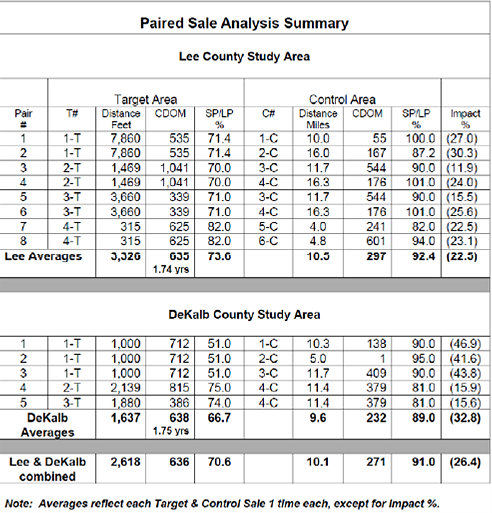
As an appraiser, I would prefer to have 5 good “comps” than 50,000 meaningless data points. In fact, many billions of dollars in mortgage loans are made across the country on the basis of 3 to 5 good “comps”. But no mortgages or sales will be based on the LBNL report…it is irrelevant for real world purposes.
Third, Assessed values may or may not be accurate. My experience dictates that AV data is not reliable for purposes of establishing value of a given property. It is merely a method of spreading the taxes levied on a supposedly uniform and ad valorem basis across the properties in a given jurisdiction. AV’s may have decreased in some locations while increasing in others, but it seems pretty consistent that Assessor’s Offices are not being compelled to seriously address local impacts from turbines. I have been told by one Assessor that “since none of the properties nearby sold, there is no basis for reducing the values”. This statement was despite the fact that several of the properties in question had been extensively marketed and could not elicit even a single offer at ANY price.
Remember, Assessors have a different job than independent appraisers; Assessors are required to assess properties uniformly, whereas appraisers are required to value each property individually and with attention to all relevant factors that affect value. Stocks are a far more “liquid” asset than is real estate typically, as it can be sold in minutes, or days at most. Real estate marketing times are an important component in setting values, and when the asset loses all or virtually all of its liquidity, that is indeed a significant value impact. One might look to foreclosure sale data to support the discount that is needed to attract a buyer of a “problem” property, in a time frame that preserves reasonable liquidity.
Finally, the LBNL study is completely inappropriate as “evidence” for developers to submit to zoning boards, when considering turbine SU permit applications. Typical Zoning Bylaw standards for approval require a finding that the “project” will not have any adverse impact on neighboring property values (as well as the public health, safety & welfare).
The LBNL report does not address this standard(s) of approval, but instead attempts to recast the question as whether turbines have a far reaching, uniform and statistically significant impact. Home sales that are not in the neighborhood of turbines are irrelevant, as is whether the impact is widespread or uniform. Zoning regulations require denial of applications when there will be ANY significant adverse impact on neighboring values, and do not provide the right for any development to diminish the value of neighboring property. The regulations also do not typically require a neighboring or abutting property owner to be “pooled” with the level of impact for an entire Town or State. Zoning regulations are intended to preserve values (etc.), but not to create sacrifice zones to accommodate wind energy development.
I trust this will help save a little time in addressing the recycled claims of no value impact from turbines. But if you choose, ignore all opinion and just go to the facts: 1,198 sales within 1 mile of turbines demonstrate a 28% lower value, and the data provides a compelling basis to determine there is a causal relationship between distance and impact.
.
Contact mikesmccann@comcast.net

Click here if you can’t directly access the video, above.

—Ella Rupprecht
I’ve been going out to Gilford township when possible, to a wooded area owned by a friend. He has acreage, and is surrounded by the turbines on three sides. There are about seven to eight turbines within a half mile radius of his property—east ,west and north.
So, Sunday I did a little walkabout. All the turbines were running and as, we know, you can absolutely hear them from all sides.
Just happens to be corn this year growing in this area. (Farmers, here, rotate corn, beans, sugar beets and wheat. This is a bonus compared to other agriculture practices since the soil here is some of the best in the world.)

“That there is some pretty soil! Imagine the color when it’s wet!” (Ella)
I walked into the corn field towards one of the turbines. I am wondering, Has anybody ever been inside a corn field when turbines are running?

Ella Rupprecht
I can tell you, the sound is eerie. (Click here and here for the videos. I should have made them longer, but I wasn’t thinking at the time.)
I don’t know if anyone is interested in what I discovered, or if this is already known. When traveling through the field, I can certainly understand why the animals would flee. The sound tunnels beneath the fields, like you’re inside an actual tunnel with noise flowing through.
The only sound is the turbines. No road traffic, nothing but turbine “whoosh” through acres and acres of land.
I felt like I was transported from the Star Ship Enterprise to the Borg Ship.


—Editorial, “Stop supporting harmful projects. Start protecting people and fixing the problems” WindAction (9/6/13)
.
Hundreds of individuals, victims and groups sent a letter today to the Northeast region’s governor and premiers asking for an end to utility-scale wind development until those projects’ impacts have been addressed.
The letter comes as the officials gather this weekend in La Malbaie for the 37th Annual Conference of New England Governors and Eastern Canadian Premiers.
“We are asking them to take clear, compelling, and compassionate steps to solve the problems they have created by supporting the deployment of ‘big wind’ in our region,” said Windwise Massachusetts president Virginia Irvine. “These projects are happening in no small part because of the legislative requirements and generous subsidies for developers pushed by Governors and supported by elected officials. Those officials need to take responsibility for what has happened to individuals and communities as a result.”
The letter highlights the many impacts of utility-scale wind projects, including stresses to the grid, the increased need for expensive transmission lines, public health issues, habitat disruption, negative impacts on tourism, increasing electricity costs, and leading to more greenhouse gas emissions.
“According to ISO New England, it will cost between $11 and $15 billion to build the transmission infrastructure needed to support the Governors’ and Premiers’ goals. Who will pay for that? Where will it go? What communities will be forced to pay the price? They need to answer those questions before they push more projects,” said Chris O’Neil, Public Affairs Director for Friends of Maine’s Mountains. “We hope they will start that discussion this weekend.”
“Wind energy is the least effective renewable energy option both economically and environmentally,” according to Lori Lerner, president of New Hampshire Wind Watch. “We oppose the continued destruction of our state’s most precious natural resources at the hands of industrial wind developers.”
Signers to the letter include physicians, PhD’s, a state poet laureate, victims of already-built big wind turbines, neighbors of areas threatened by big wind projects, groups grappling with wind energy development, and individuals from throughout New England.
The noise and human health concerns raised by residents living near the Falmouth Massachusetts wind turbines are not isolated cases. Luann Therrien is a neighbor to the Sheffield VT wind project whose family (including two young children) has been suffering health problems for more than a year. “The developers lied about the noise from these giant machines, and the health impacts they create,” she said. “Headaches, nausea, sleep disruption – it’s happening right now to our family and too many others. Lives are being ruined, homes and futures are being destroyed. This has to stop. At conferences like the one this weekend, protecting public health has to be on the agenda.”
The letter calls on the region’s governments to increase their coordination and share resources to better respond to the issues created by wind development. It asks officials to, “Revise or withdraw your plans that support the expansion of wind and a wind build out in rural areas to support the urban areas. Start evaluating and fixing the problems that have been created by your policies.”
“As the letter states, we need a respectful, honest dialogue about all of these issues,” Annette Smith of Vermonters for a Clean Environment said. “We don’t have ramping plants, so these projects can increase, not decrease, our region’s greenhouse gas emissions. Why aren’t we talking about that? People are as we speak getting sick and being forced to abandon their homes. Let’s have a conversation that addresses what is happening now that so much big wind has been developed in our region. Until these problems are resolved, it would be irresponsible for the Conference to continue to advocate for even more utility-scale wind projects in our region,” she concluded.
#####
Selected comments from letter signers:
We are having adverse property value around the lake, my parents in Barton are having adverse health effects, noise, and drop in their property values.
Industrial wind energy projects cause social upheaval. They can set neighbor against neighbor and pit towns against one another. Wind developers foment and exploit these divisions and the result is long-lasting damage to communities.
**************************
As a Maine resident who cares deeply about Maine’s environment, I strongly oppose Industrial Wind Energy development in our state and all Industrial Wind in general. It is a fact that it is not effective in reducing CO2, it’s too expensive and seriously degrades our quality of Place and our health!
**************************
We are victims whose property is less than 1000 feet from 1.65 MW turbine; 3 turbines can be heard and felt here. This siting is unacceptable; distance is key. Fix EXISTING problems and don’t make mistakes again!
We support significant further research and serious pause before any wind factory projects on our irreplaceable ridgelines. We also support more transparent information as to who the REAL stakeholders are as well as research into permanent ecological damage and health risks for the people involved, no less permanent property value loss and resulting damage to the local economy without any accountability regarding the wind factories!
**************************
I endorse this letter. I would clarify that “Big Wind” can be just 1-2 industrial-sized turbines in certain climates and coastal areas, and that New England does not have an auspicious wind resource even for smaller wind generators. There are many opportunities for distributed solar on rooftops, solar parking canopies and brownfields.
**************************
The wind turbines are really not going to remedy our power situation. I will not list all the drawbacks to these monster towers on the mountains overlooking Newfound Lake. I was told by the selectmen of my town that my taxes are high and I am paying for the view, and now it looks like the view will change very radically. This is a minor consideration compared to the damage done to the environment and the power produced will not be used by the people of NH, or so I’ve been told. Please don’t let this happen.
**************************
I am a victim. I can hear the throbbing turbines from Iberdrola’s Groton Wind Plant located 2 miles to the east of my home through dense woods. The EDPR’s Spruce Ridge Wind Plant is a second industrial wind facility proposed within 2 miles to the south west of my home, with no vegetative buffer. The Juwi North America’s Alpine Ridge Wind Plant is a third proposed industrial wind facility within 1 mile to the west of my home, with no vegetative buffer. The Iberdrola Wild Meadows Wind Plant is a fourth proposed industrial wind facility within 10 miles of my home.
In total, approximately 100 500 foot turbines could be located on the mountain ridges surrounding my home. I am scared to death what this will do to my health and well being, as well as my neighbors’, the quality of the watershed and the fragmenting of wildlife. My home is located in one of the highest ranked wildlife habitats in New Hampshire.
**************************
These industrial sized wind turbine projects have divided towns and countries so much like the Derby Line wind project did. Dividing people and neighbors who will never speak again all for greed. At least we do not have a project here, I really feel for those that have to put up with the monstrosities.
**************************
I am an individual who had a wind turbine project proposed for adjacent to my neighborhood but due to the fact that in our town we had the benefit of notification, unlike many communities in Massachusetts, we were able to educate ourselves as to the true cost and benefits. In the end our town officials opted to pursue a more benign renewable energy platform, and our wind project was tabled.
The proposed turbines are too big and emit too much noise energy. Highland Windfarm, LLC, is proposing a grand experiment with the Town residents as the guinea pigs”
—Paul D. Schomer, PhD, Noise Engineer, testimony before the Wisconsin Public Service Commission, July 29, 2013
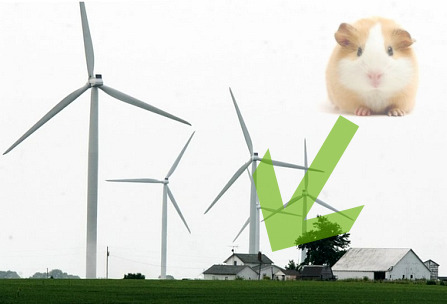
Editor’s note: The following testimony by Dr. Paul Schomer is of great importance to any community currently facing the prospect of wind turbines. Dr. Schomer is a seasoned noise engineer with considerable experience measuring wind turbine noise emissions. He has now become convinced that (a) wind turbines do in fact cause direct health effects (as opposed to the silly, even inane, idea proposed by Simon Chapman and Geoff Leventhall [and here)] that this is all a matter of “nocebo” effect—that is, “power of suggestion”); (b) he argues that the current generation of huge turbines is inappropriate for communities of people; and (c) he scoffs at the facile and clueless efforts of wind company-hired noise engineers to somehow curtail the infrasound emissions.
Below are excerpts from Schomer’s recent (7/29/13) testimony before the Wisconsin Public Service Commission regarding a proposed windplant in the Town of Highland, Wisconsin.
Click here for the full, original document.
.
“Rehearing direct testimony Paul D. Schomer” (7/29/13) Application of Highland Wind Farm, LLC, for a Certificate of Public Convenience and Necessity to Construct a 102.5 MW Wind Electric Generation Facility and Associated Electric Facilities, to be Located in the Towns of Forest and Cylon, St. Croix County, Wisconsin. Docket No. 2535-CE-100
» “Highland is proposing a grand experiment with the Town residents as the guinea pigs. The proposed turbines are too big and emit too much noise energy. In the wake of the severe health impacts experienced by some residents in the Town of Glenmore, which has similarly large turbines, it is troubling that Highland refuses to consider a full redesign of this project.”
» “There is significant evidence from all over the world that large turbines placed too close to residences cause very serious health problems. While the research is underway, there is continuing focus on balancing the size and output of wind turbines with public health. I do not believe that the right balance has yet been struck. The wind industry continues to claim that there is no known link between wind turbine noise and health effects.”
» “In a recent paper, which is being submitted as Ex.-Forest-Schomer-20, I show that for a small group of specially selected people, the probability that motion sickness-like symptoms experienced by wind farm residents are unrelated to wind turbine noise is less than two in a million. This analysis proves that it is virtually certain that these individuals are adversely affected with serious health effects that result from the acoustic emission of nearby wind turbines. This changes the dynamic of the situation. Since it can no longer be said that there are no known health effects related to wind farms, it follows that the industry must prove that there will be no adverse health effects from what they plan to do, or that the industry must state what the adverse health effects will be.”
» “In a paper to be presented and to be published in December 2013, which is being submitted as Ex.-Forest-Schomer-22, we show that the Massachusetts study’s conclusions about the lack of connection between human health and infrasound and wind turbine noise are flat out wrong.”
» “All the experts in this proceeding agree that the louder the turbines are in audible noise and the larger the turbines are in structure, the more infrasound will be produced. The larger mega turbines seem to correlate very starkly with health impacts. It is significant that in a wind farm with only eight turbines, three families have left their homes in the Town of Glenmore. As I testified earlier, if this farm is built as designed, it is likely that the same result will occur – with or without curtailment.”
» “Infrasound flows in all directions and its amplitudes are not reduced by which direction the sound originates. Adverse health effects from infrasound will not be abated by directivity. This is another reason to stick with ISO 9613-2 and IEC 61400-11, each as is, and not venture into the unknown.”
» “The history of wind turbines, as young as they are, is one of ever increasing size. Current units go from 1.5 to 3.5 MW, and bigger units can be expected in the future. Larger turbines may have the advantages of greater efficiency and net profit but they create more problems for people living close by. There is strong evidence that the very low infrasound frequencies produced by large wind turbines are the sources of acoustic emission that are adversely affecting people. As the power generated by wind turbines grows, the blades grow and hence the tip’s speed is reduced to avoid too high an advancing blade tip Mach number.”
» “According to a paper by van den Berg (2004), which is being submitted as Ex.-Forest-Schomer-22, the increase due to a typical nighttime wind profile (the change in velocity with altitude) was 5 dB for a wind turbine with a 58 m hub height, and up to 15 dB for a turbine with a 98 m hub height. That is, the increase in low frequency energies in size and magnitude may be substantial because of this blade-loading, wind-gradient effect, much greater than what is predicted for constant blade loading. The conclusion is that unless mitigation methods and strategies can be developed and implemented, bigger turbines are not necessarily better. They may actually be much worse for people.”

The wind industry is hiding over 90% of the bird and bat mortality caused by their turbines. This statement is supported by the industry’s own data and reasonable adjustments for its manipulations.
“The wind industry is … producing faulty, misleading and even fraudulent documents to hide the serious and growing mortality. This situation has continued for years but has been shielded by state and federal agencies and other supporters of wind power.
—Jim Wiegand, MasterResource (9/4/13)
.
A “green energy” wildlife genocide is depopulating wildlife habitats across the world where vital species once found refuge. Industrial wind turbines have invaded these habitats and are devastating bird and bat species.
Rather than avoiding these critical habitats or taking steps to minimize impacts on important species, the heavily subsidized wind industry is responding by producing faulty, misleading and even fraudulent documents to hide the serious and growing mortality. This situation has continued for years but has been shielded by state and federal agencies and other supporters of wind power.
Having studied these installations and their wildlife impacts for years, I can say without reservation that most of what people hear and read about the wind industry’s benefits and environmental costs is false. However, buried in thousands of pages of wind industry documents are data, omissions and calculations that tell a wind turbine mortality story that is far different from what is portrayed in industry press releases, mainstream news stories and official government reports.
I have frequently said the wind industry is hiding over 90% of the bird and bat mortality caused by their turbines. This statement is supported by the industry’s own data and reasonable adjustments for its manipulations. These calculations will help people understand how the industry is using its studies to hide millions of fatalities; they will also help local residents and officials understand “wind farm” impacts and their role in species extinctions that could soon exact an irreversible toll in many regions.
My analysis focuses on two North American wind resource areas that are well known for killing raptors, other birds and bats: Altamont Pass in southern California and Wolfe Island in eastern Lake Erie, on the Ontario-New York border.
While studies prepared for these two wind resource are quite different, both were designed to hide mortality. Indeed, hiding mortality is an industry-wide practice, and it is easy to discredit any mortality or cumulative impact study produced by wind energy developers.
Altamont Pass Tricks
The Altamont Pass Wind Resource Area (APWRA) provides an excellent introduction to this problem. Its environmental impacts have been well publicized, but now the industry wants to replace small older 50- and 100-kilowatt turbines with huge 2.3-megawatt turbines that it claims are safer. This claim is without merit. Industry studies used to promote the plan are deeply flawed and the much larger 2.3 MW turbines will add more than twice the deadly rotor sweep to Altamont, along with much faster blade tip speeds.
Probably more studies have been conducted in Altamont Pass than at any other wind farm in the world. Unfortunately, however, the wind industry has used that information and lessons from the public relations firestorms those studies ignited to develop clever methods for hiding bird and bat mortality impacts.
One of the most effective methods is limiting searches for dead and injured wildlife to progressively smaller areas around increasingly larger turbines – thereby omitting increasing numbers of fatalities as larger turbines catapult birds and bats further, often into grass, brush and wooded areas that hide bodies.
For the relatively small 50-100 kW turbines at Altamont, roughly 85% of fatalities can be found within a 50-meter search radius, which suggests that this radius is appropriate, if the missing 15% are accounted for. But even with these turbines, industry-paid researchers are able to hide Altamont’s true mortality figures by employing improper study methodologies, raw data manipulation and inaccurate methods for estimating annual death tolls.
All wind turbine mortality studies find bodies. Indeed, some researchers say wind turbines provide a fatal attraction for birds and bats. It is how carcass counts are conducted and interpreted that renders the process faulty or fraudulent – while also enabling the wind energy industry to claim it has satisfied commitments to reduce bird and bat mortality, and thereby justify installing much larger (and potentially deadlier) wind turbines. Comparing earlier and more recent studies illustrates how this is done.
In a 1998–2003 study, raptor carcasses were found in searches conducted about six weeks apart. Analysts then developed and applied numerical factors designed to account for the facts that: on-the-ground teams were likely to find only a certain percentage of all dead and injured birds and bats; some wounded individuals would crawl off and die elsewhere; and coyotes, ravens and other scavengers would remove and eat many turbine victims.
Applying those factors to actual carcass counts, researchers calculated that Altamont turbines were killing 116 golden eagles per year (an average of 10.8 times the actual carcass count per year) Wind turbine mortality for red-tail hawks, burrowing owls and American kestrels were likewise estimated by using factors of 7 to 28 times actual body counts.
The study demonstrated that Altamont wind turbines were having a devastating impact on Diablo Range populations of raptors and other birds. It explained why many nests were no longer occupied and why fewer and fewer of these species were seen in succeeding years around the Bay area foothills. As a result of this impact the wind industry realized it had to reduce the death tolls dramatically – or at least make it appear that the tolls were decreasing to minimize public outrage.
Manufacturing a Decline
In 2012, Altamont Pass turbine operators released the results of their 2005–2010 study. They claimed they had achieved substantial reductions in raptor and other bird mortalities, and that part of this reduction resulted from the industry replacing small older turbines with much larger new units.
The claim raised questions and eyebrows among knowledgeable bird researchers, who know that mortality searches at Altamont are still finding an increased number of bodies amid the turbines. They also know there are many ways to manipulate mortality studies to achieve the desired outcome.
For instance, industry-paid researchers arbitrarily reduced their golden eagle death estimating factor to one-fifth of their previous (10.8) body-to-carcass ratio (down to 2.2); otherwise their estimated mortality would have been an intolerable 200 eagles per year. They slashed mortality factors for the other raptors (originally 7 to 28 times actual body counts) to between 2.2 and 7.6 times. This was done even though turbine size, blade length and area swept by the bird-butchering blades had skyrocketed.
The only way these changes make sense or can be justified is by recognizing that these bird populations have already been decimated so many times that the species are now rapidly declining in the area, and this wind facility is killing off a higher percentage of the smaller remaining population. Other realities are also involved, however.
On the largest turbines, researchers continue to use an undersized 75-meter search radius, even though the much larger turbines are known to catapult birds and bats much further from turbine towers. They may also be attributing mortality from the large turbines to the smaller ones nearby (see Figure 1). While the smaller 75-meter search area is generally fine for the 50-100 kW turbines, since some 85% of all fatalities are found within that search radius, the search radius must be much wider (200-250 meters) for the 2.3-MW turbines, to achieve valid results.
In addition, hundreds of carcasses were eliminated from mortality estimates, because they were picked up by wind farm personnel ahead of searchers looking for high priority species like eagles and hawks.
Researchers are also assuming higher search efficiencies; that is, a suddenly increased ability to spot bird carcasses. But the improved search efficiency rates are themselves based on studies that cannot possibly be considered credible. They used dead pigeons, gulls and ravens, whose white and black feathers make them easy to spot on gravel pads around turbines – instead of the primary species, whose camouflaged bodies are hard to see.
For example, a study intended to determine how many bird carcasses are removed by scavengers used Japanese quail bodies that were too big for Altamont’s most prolific scavengers (gulls, ravens and crows) to remove. This made it appear that scavengers are eating few of the turbine fatalities, which again lowers mortality calculations. In addition, an equally clever and far more sinister tactic is also being employed.
First Remove, then Search
Instead of daily searches over a period of several weeks, mortality studies employ occasional searches conducted only every 30 to 90 days. This virtually ensures that small birds and bats are removed, decay and/or are eaten. Studies from across the country indicate that nearly 90% of small carcasses vanish in the first two weeks, and 97-100% are gone within 30 days. This is especially true for Altamont Pass, where thousands of gulls patrol for food. It also explains why Altamont searchers found only 21 bat carcasses, whereas probably thousands were consumed during the six-year study.
The 2005–2010 data from Altamont recorded an average of 372 small carcasses per year. However, applying a 85% search area factor, a small bird searcher efficiency rate of 38-40% (based on other studies), and a 97% removal rate (3% remaining) after 36 days of scavenger activity reveals that the annual death toll for small birds at Altamont is actually much closer to 73,000 to 76,840 for its current 500 MW of installed capacity.
This is why daily searches are so important. It is also why they have been avoided. With each passing day, the mortality data become less reliable – and without a body, if nearly all the carcasses of a species vanish, searcher efficiency and scavenger removal rates mean nothing. Scavenger removal for small birds and bats are known to be 100% within 21 days at some wind turbine locations, and without a body there are no data to extrapolate.
In short, the methods used at Altamont (and other wind energy facilities) violate scientific integrity principles. But they are perfect for hiding true mortality counts. The 24 hour search intervals are critical for reliable data. Even mortality studies going back decades on communication towers used daily searches for the most reliable carcass data.
However, the US Fish and Wildlife Service, California Fish and Wildlife Department, and supposed bird protection groups have given the wind industry carte blanche to write its own study criteria and kill countless protected birds and bats. That is something these groups have never done for any other industry. Wind energy gets a pass, because it is supposedly reducing America’s “carbon footprint,” these groups do not want to sully the wind industry’s eco-friendly reputation, and the industry in turn provides generous contributions to environmental groups and politicians that support wind energy.
The 48-hour Study
Altamont Pass researchers are well aware that they are missing thousands of birds and bats in their mortality studies. That is why they insist on using 30-90 day search intervals when looking for carcasses. They want these carcasses to disappear.
This conclusion is supported by a four-month study conducted at Altamont Pass several years ago.
Areas around roughly 24 MW of Altamont Pass turbines were searched using 48-hour search intervals. This 48-hour window is important, because thousands of gulls and other scavengers patrol the Altamont wind turbines looking for easy meals around the turbines (and often get killed themselves).
Searchers looking in undersized 40-meter search areas found 70 small bird carcasses. After adjusting for these undersized search areas, injured birds (which will die but are not counted by the wind industry) and carcass removal, I rounded the four-month total to a conservative total of 100 small birds. At first blush, this appears to be a tolerable bird kill (unless it is compared to prosecutions for the accidental deaths of 28 common birds in oil and gas facilities over an entire state during an entire year).
However, once these 100 birds are used to calculate mortality counts for Altamont’s total installed capacity (2008) of 580 MW and a full twelve months, the small bird kill rate soars to 7,250 per year. Combining this body count with a reasonable searcher detection rate of 40% and a credible scavenger removal rate of 30% over two days results in an estimated total of 25,900 small birds per year! If the scavenger rate is boosted to an equally reasonable rate of 60% over a two-day period, small bird mortality jumps to 29,500.
That’s 925 to 1,050 times more birds than resulted in the federal prosecution of seven oil companies in North Dakota in 2011 with no investigation or prosecution of wind companies. It is also ten to eleven times more small birds than the 2,700 fatalities that Altamont operators admitted killing per year, based on their “eco-friendly” research methods during the period when the 48-hour study was conducted.
Proper Studies for the Real Death Toll
Considering the critical analysis presented in this article, it seems very reasonable to conclude that new studies employing proper search areas, trained dogs, 24-hour search intervals and no pre-search collecting of birds by wind energy employees would produce far greater totals – easily exceeding 25,900 small birds per year, plus thousands of bats, raptors, and other birds.
There can be no doubt that the Altamont mortality is far greater than what is being reported. In my opinion, Altamont pass is actually killing 50,000-100,000 birds and bats per year and has been for decades. And that is only the tip of the proverbial iceberg of wind turbine mortality, considering that more than 40,000 turbines are now operating in the United States, many of them in or near important bird and bat habitats.
As Paul Driessen, Mark Duchamp and others have concluded, based on careful bird and bat mortality studies in Spain and Germany, it is highly likely that the 40,000 US wind turbines are killing between 13 million and 13 and 39 million birds and bats every year – including hundreds of bald and golden eagles, thousands of hawks, falcons, owls and other raptors, and dozens of extremely rare whooping cranes!
My own previous articles (here and here) strongly suggest that these conclusions are accurate.
No wonder the taxpayer and consumer subsidized wind industry is so intent on rigging its mortality methodology and making sure that no meaningful or accurate studies are conducted. They would raise such a public outcry that nearly all 40,000 turbines would be shut down.
Considering the trivial amount of electricity they produce (less than 2% of all US electricity output) and the vanishingly small amount of carbon dioxide they reduce, though, even a nearly total wind turbine shutdown would be justified and would hardly be noticed.
References
Altamont Pass Wind Resource Area Bird Fatality Study, Bird Years 2005–2010, Prepared by ICF International (Doug Leslie, Jesse Schwartz and Brian Karas) for Alameda County Community Development Agency, November 2012.
Altamont Pass Wind Resource Area Bird Fatality Study, Prepared by ICF International for Alameda County Community Development Agency, January 2011.
Draft Altamont Pass Wind Resource Area 48-Hour Search Interval Bird Fatality Study (kestrel/burrowing owl report), prepared by ICF Jones & Stokes for Alameda County Community Development Agency, June 2009 (M32).
Developing Methods to Reduce Bird Fatalities in the Altamont Wind Resource Area,Final Report by BioResource Consultants (Smallwood, K. S., and C. G. Thelander) for the California Energy Commission, August 2004.
2008/2009 Annual Report for the Buena Vista Avian and Bat Monitoring Project, prepared by Insignia Environmental for Contra Costa County, September 4, 2009.
Post-Construction Avian And Bat Impact Assessment of the University of Delaware Wind Turbine in Lewes, DE, Jeffrey Buler, Kyle Horton, & Greg Shriver, Department of Entomology and Wildlife Ecology, University of Delaware, May 2012.
An Estimate of Avian Mortality at Communication Towers in the United States and Canada, Longcore T., Rich C., Mineau P., et al., PLOS-one, April 25, 2012.

Editor’s note: The next time a wind turbine salesman tells your town board that “wind farms,” interlinked over a widely dispersed area, provide constant, realistic energy to the energy grid—stand up and inform him that he’s a liar. (If you have not yet learned this, better learn it now: Wind energy companies “make up” facts as they go along, like snake-oil salesmen have done for millennia.)
They fabricate this piece of information, as well. Paul Miskelly, an Australian engineer, carefully examined “operational data for 21 large wind farms” in eastern Australia over a 12-month period, at 5-minute increments, and discovered that wind energy is a flop. Worse than a flop, it’s a real hazard to grid stability.
Click here for the full article.
Abstract
Academic discussion continues as to whether a fleet of grid-connected wind farms, widely dispersed across a single grid network, can provide a reliable electricity supply. One opinion is that wide geographical dispersion of wind farms provides sufficient smoothing of the intermittent and highly variable output of individual wind farms enabling the wind farm fleet to provide for base load demand. In an examination of the 5-minute time-averaged wind farm operational data for 21 large wind farms connected to the eastern Australian grid – geographically the largest, most widely dispersed, single interconnected grid in the world (AER, [1]) – this paper challenges that opinion. The findings also suggest that the connection of such a wind farm fleet, even one that is widely dispersed, poses significant security and reliability concerns to the eastern Australian grid. These findings have similar implications for the impact of wind farms on the security of electricity grids worldwide.
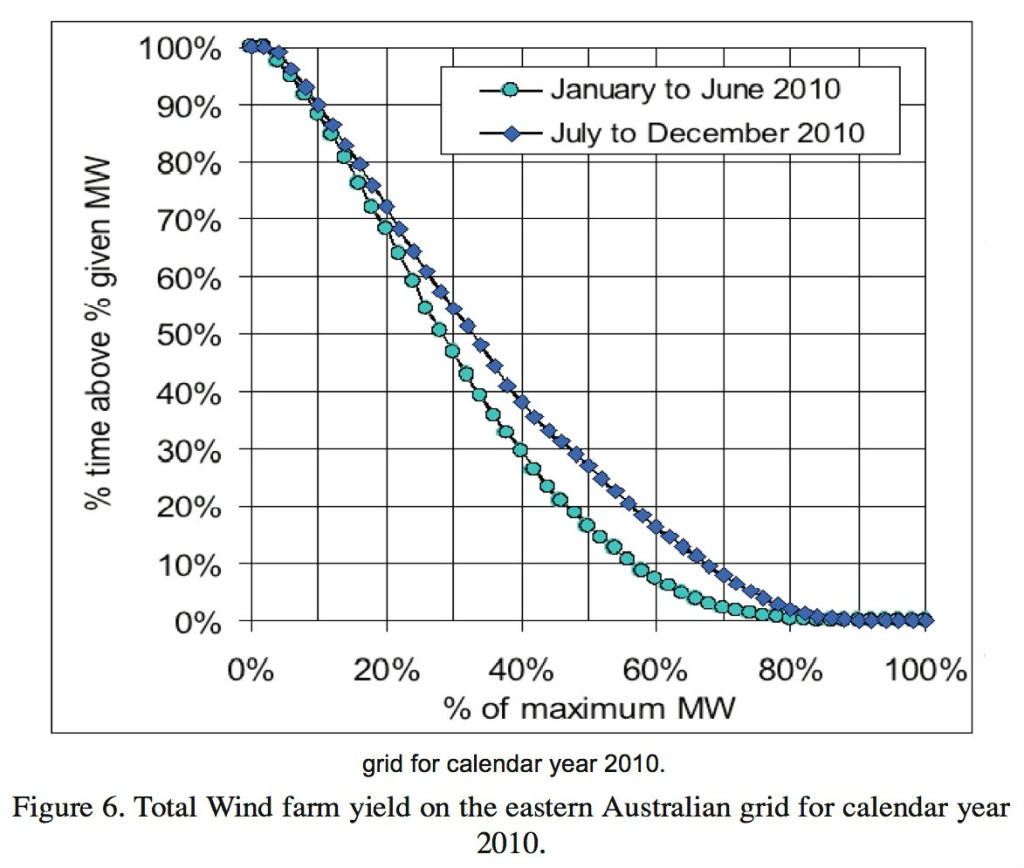
Conclusion
Engineers are required to do more than merely analyse and report on natural phenomena. They are required to create practical solutions to real world problems. In so doing they must test and design systems ensuring that they have addressed the worst case scenarios. As a result, they may not concentrate merely on average values. With these requirements firmly in mind, to the electrical engineer, a careful scrutiny of the available wind farm operational data shows that, on the eastern Australian grid, it is not possible for wind energy ever to displace dispatchable, reliable generation supplying the base load demand. In this regard, an examination of the graphs comprising Figure 3 clearly indicates that the proposal by some Australian policymakers to replace major coal-fired power stations with a fleet of wind farms is not technically achievable.
Additionally, the analysis shows that further increased wind penetration, even if spread evenly across the eastern Australian grid, will result in an increasing contribution to grid instability, potentially making wind energy an increasing threat to grid operational security and reliability. To continue a policy strategy to increase wind penetration across the eastern Australian grid, to seek to meet a target of some 20% installed capacity, as has already been achieved in South Australia, (with the presumption that wind may thereby meet 20% of base load requirements), has the potential to be a dangerous strategy.
To address the increased instability due to wind, a fleet of fast-acting OCGT generation plants may well be required to back up wind’s intermittency. The use of a significantly greater proportion of this form of generation, rather than the more thermally-efficient CCGT, in the gas-fired generation plant mix may lead, seemingly paradoxically, to both higher gas consumption and higher GHG emissions from the resulting OCGT/CCGT generation mix than if wind generation was not included in the generation portfolio.
As the eastern Australian grid is:
» the world’s most geographically dispersed single interconnected grid,
»as the present wind farm fleet is dispersed across it at its widest portion in the east-west direction, that is, in the direction of the prevailing mesoscale atmospheric circulation,
» and that this fleet also occupies a significant region in the north-south direction,
these conclusions are significant for grids worldwide.
Editor’s note: The following is the preface to Esther Wrightman’s new webpage, “The Poetry of Esther Wrightman.”
.
 .
.
.
—Calvin Luther Martin, PhD, author of “The Way of the Human Being” (Yale) and “The Great Forgetting” (K-Selected)
Last month, the Canadian author Alice Munro made international news when she announced she was laying down her pen. “No more books; I’m done.”
For me, the news was especially poignant. Alice Munro is not Canadian so much as she is Ontarian—a place dear to my heart. I’ve jogged its back roads, listening to the soothing rasp of crickets, filling my lungs with the pungency, sweetness and musk, heat and summer brightness of its fields. I have canoed its lakes. I’ve lived there.
Rural Ontario grew Alice’s voice, just as it grows meadowlarks, bobolinks and swallows. And now her familiar voice is fading, though crickets and fireflies still define the night, and sweetgrass, clover, and marsh willows still bend before playful winds.
I rejoice to announce that another voice is being born from this same soil. A poet’s voice, this time. Quietly thrusting up through the same humus, like some new, never seen before, wildflower.
Esther Wrightman refuses to acknowledge she’s a poet. (One isn’t sure how to respond. Perhaps best to say nothing—and pretend she never said it or you heard her wrong.)
Read Wrightman’s poems, herein, then open any collection by the Pulitzer Prize and National Book Award-winning Cape Cod poet, Mary Oliver. Start reading. If you want to be more precise about it, start with “Trilliums.” Then “Sleeping in the Forest” and “White Night.” Then “Storm” and “Bone Poem.”
Now take a look at Dylan Thomas’s “Fern Hill.” Perhaps even Frost’s “Birches.”
You see my point. If Wrightman’s not a poet, neither are they.
Still, I doubt this will make her change her mind. (She’s descended from Scots and Mennonites.)
Really, so long as she keeps writing, what does it matter what she calls herself?
There is an urgency in my question. Rural Ontario is under assault—from giant, useless, habitat-destroying and (literally) sickening wind turbines. It is also being targeted by so-called “hydro-frackers”: madmen who inject a toxic chemical cocktail into the earth’s crust, to release and spew out the natural gas entombed there.
The Ontario that nurtured Alice Munro and Esther, and me, is wounded. Esther writes out of this passion and wound—a personal wound, since her township is the center of much of the battle against this terrorism, as she calls it.
There is a larger reason I hope she keeps writing. We live in a world where “man’s mind [has] grown venerable in the unreal,” eerily removed from the magic of earth, water and sky (Wallace Stevens, “Credences of Summer”). Removed from what Aldous Huxley called Mind at Large, from Stevens’s “amassing harmony.”
There was a muddy centre before we breathed
There was a myth before the myth began,
Venerable and articulate and complete.—Wallace Stevens (from “It Must Be Abstract”)
We need Esther’s perception of that “muddy centre.” We need to see, through the amassing harmony of her mind, what she sees.
Certainly, I need to. After a life as a university professor and author of books, I no longer require a lesson in economics or political science or history or biology. I am unrepentantly beyond all this.
When despair grows in me
and I wake in the middle of the night at the least sound
in fear of what my life and my children’s lives may be,
I go and lie down where the wood drake
rests in his beauty on the water, and the great heron feeds.
I come into the peace of wild things
who do not tax their lives with forethought
of grief. I come into the presence of still water.
And I feel above me the day-blind stars
waiting for their light. For a time
I rest in the grace of the world, and am free.—Wendell Berry, “The Peace of Wild Things”
Esther Wrightman brings me into the peace of wild things.